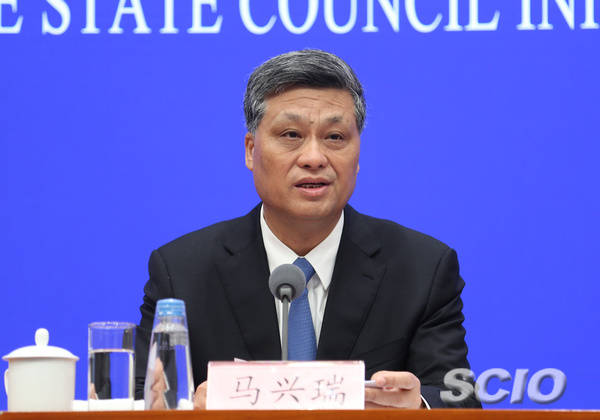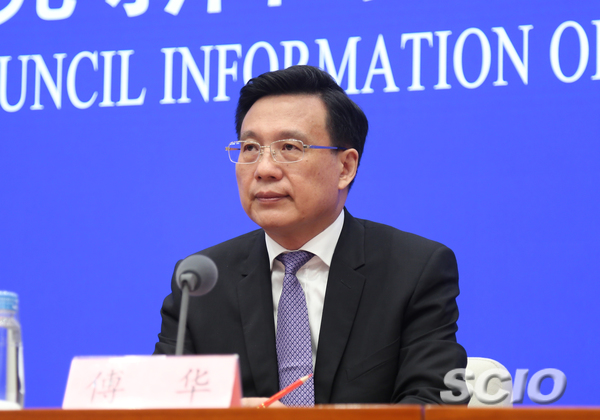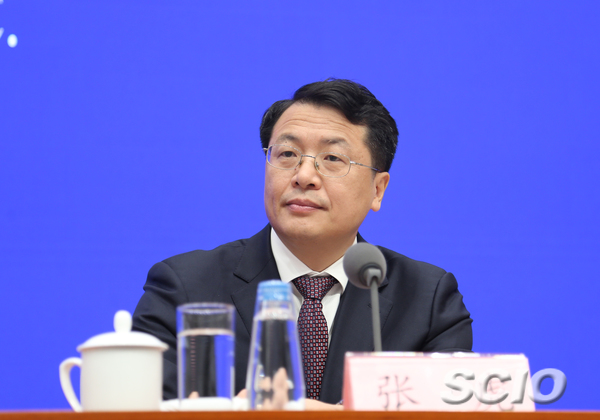Guangdong: 70 years on
Editor's Note:
Starting in May, the State Council Information Office has been holding news conferences for each province, autonomous region and municipality to give briefings about their social and economic development since the founding of New China 70 years ago.
During the Guangdong session on June 3 in Beijing, Ma Xingrui, the governor of the province, made a keynote speech on the overall development of Guangdong. Fu Hua, director-general of the CPC Guangdong Provincial Committee Publicity Department, and Zhang Hu, the vice-governor of Guangdong province, answered questions raised by reporters.
 |
|
Ma Xingrui, governor of Guangdong province, on June 3 outlines the great achievements Guangdong has made over the past 70 years since the founding of New China. [Photo by Zhang Xin/scio.gov.cn] |
Economic overview
The province's GDP increased from 2.03 billion yuan ($290 million) in 1949 to 9.7 trillion yuan in 2018, leading the country for nearly 30 years, and Guangdong's GDP is expected to surpass 10 trillion yuan in 2019. Revenue in the general public budgets in 2018 hit 1.2 trillion yuan, 3,750 times that of 1950 (320 million yuan). Guangdong has taken steps to promote all-round opening-up and build an open economy at a higher level.
In 2018, its total volume of foreign trade reached 7.16 trillion yuan, which accounted for about 25 percent of the country's total amount, ranking first in China for 33 consecutive years, and Guangdong's actual utilization of foreign capital totaled $447 billion in 2018.
Guangdong, a world-class manufacturing base, is home to 47,500 industrial enterprises above designated size. A relatively complete and perfect modern industrial system has taken shape in the province, one that includes traditional and advanced manufacturing industries such as electronic information, green petrochemicals, automobiles, smart household electrical appliances, and robots, and the gross output of the electronic information industry accounted for 34 percent of the country's total.
Guangdong has set up a comprehensive transport system of waterways, highways, railways and airports, and its urbanization rate rose to 70.7 percent. The livelihoods of its residents were improved, and more than 2.4 million people were lifted out of poverty.
 |
|
Fu Hua, director-general of the CPC Guangdong Provincial Committee Publicity Department, says Guangdong government will take Lingnan culture as a linking bridge to promote innovative development of the excellent traditional Chinese culture in the Guangdong-Hong Kong-Macao Greater Bay Area. [Photo by Zhang Xin/scio.gov.cn] |
Construction of the Guangdong-Hong Kong-Macao Greater Bay Area The Guangdong-Hong Kong-Macao Greater Bay Area brought in great opportunities for Guangdong's reform and opening-up in the new era. The government will put emphasis on improving the business environment in the area, in order to embrace the free flow of human resources, logistics, capital and information.
Guangdong aims to develop the Guangdong-Hong Kong-Macao Greater Bay Area into an international scientific and technological innovation center. The government will accelerate the construction of major technological infrastructure such as national key laboratories and large scientific institutions, and provide preferential tax reduction policies to attract more outstanding talents.
Hong Kong is seen as a center of international finance, shipping and trade, while Macao has remained a global tourism and leisure center, and Guangdong is a manufacturing, foreign economy and trade province, all of which will provide strong support for the construction of the Belt and Road Initiative.
Infrastructure interconnectivity will be further promoted. The Liantang/Heung Yuen Wai Boundary Control Point, a new port to be built by 2019, and the new channel linking Zhuhai and Macao will open to traffic by the end of 2019, all of which will promote the coordinated development of the area's high-speed railways, ports and airports.
Guangdong plans to make the Greater Bay Area into a high-quality life circle with livability, adaptability and sustainability. A wide range of supportive policies for innovation and entrepreneurship will be provided for youth from Hong Kong and Macao. At the same time, the government will promote ecological environment protection, and create a healthier living environment.
 |
|
Zhang Hu, the vice-governor of Guangdong province, outlines the development of Guangdong's digital government. The province promotes the Internet Plus innovation project to improve government services. [Photo by Zhang Xin/scio.gov.cn] |
Reform and opening-up in the new era
Guangdong has been committed to deepening overall reform and opening-up over the years, with its socialist market economy "with Chinese characteristics" improving a great deal and creating a better business environment in the Greater Bay Area.
The construction of the Guangdong-Hong Kong-Macao Greater Bay Area has started well. This year, the central government unveiled the Outline Development Plan for the Guangdong-Hong Kong-Macao Greater Bay Area, which has been put into full operation. The opening of Hong Kong-Zhuhai-Macao Bridge, and the Guangzhou-Shenzhen-Hong Kong Express Rail Link has worked like a siphon to attract talents, capital, technologies and enterprises.
The Guangdong government has firmly implemented an innovation-driven strategy and highlighted the role of technologies in industrial upgrading. In 2018, the province put more than 250 billion yuan into research and development expenditure, and the number of international patent applications via the Patent Cooperation Treaty (PCT) in 2018 made up 50 percent of the country's total, with its regional innovation ability maintaining first place in China.
The province is home to 45,000 national high-tech enterprises, and the added value of the advanced manufacturing industry accounted for 56.4 percent of the province's industries above a designated scale, and the contribution rate of tertiary industry to the province's GDP climbed to 58.9 percent.
The province also has made significant achievements in tackling pollution, and improving ecological and environmental quality. The average concentration of PM 2.5 in the province dropped by 31 micrograms per cubic meter in 2018, and the Pearl River Delta in the province was listed as the country's first national forest city cluster construction demonstration area.



 Print
Print Mail
Mail